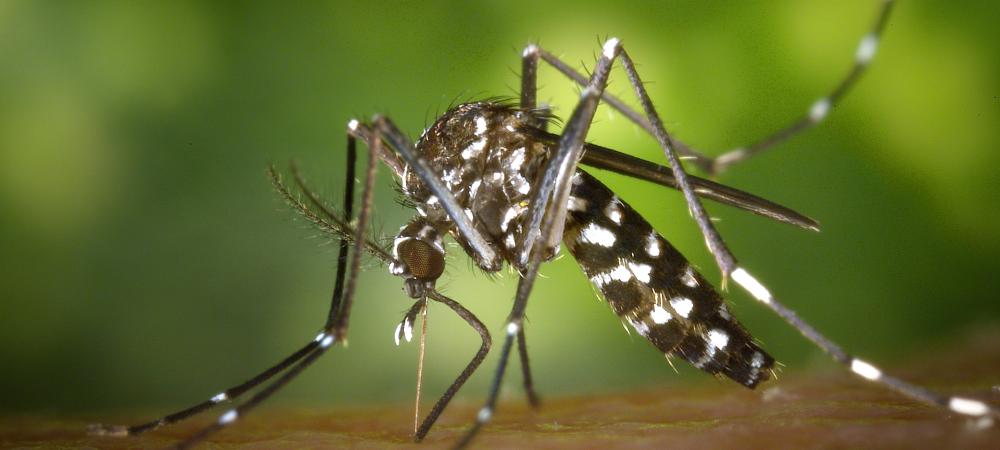What Do Mosquitoes Look Like?

Are you being bothered by flying, biting pests in your backyard? Here are some tips and tricks when it comes to identifying mosquitoes.
Body Structure
Mosquitoes belong to the family Culicidae and are insects characterized by a distinct body structure. Adult mosquitoes are generally small, ranging from 3 to 6 millimeters in length. Their slender bodies consist of three main parts: the head, thorax, and abdomen.
Head
- Mosquitoes have a small, triangular-shaped head, which houses various sensory organs and mouthparts.
- The antennae, located on the mosquito's head, serve as sensory organs that help them detect environmental cues.
- Their compound eyes, made up of numerous tiny lenses, provide them with a wide field of view, aiding in navigation and locating hosts.
Thorax
- The thorax is the middle section of a mosquito's body and is crucial for flight.
- Attached to the thorax are three pairs of legs and two pairs of wings.
- Mosquitoes are adept flyers, capable of hovering and navigating through various terrains to find suitable breeding grounds and hosts.
Abdomen
- The abdomen is the mosquito's elongated posterior section, housing vital organs such as the digestive and reproductive systems.
- Female mosquitoes have a more robust and larger abdomen compared to males, as they require additional space for egg development.
Distinctive Features
Aside from their body structure, here are some other distinctive characteristics of mosquitoes:
Proboscis
One of the most distinct features of mosquitoes is their elongated mouthpart, known as a proboscis. The proboscis allows mosquitoes to pierce the skin of their hosts and feed on blood, a behavior primarily exhibited by female mosquitoes.
Wings
Mosquitoes have two pairs of delicate wings, usually with scales that give them a distinctive appearance. These wings enable them to fly silently, a crucial adaptation for avoiding predators and efficiently seeking out hosts.
Coloration
Mosquitoes come in various colors, including brown, gray, black, and sometimes with distinctive markings, which aids in camouflage against various backgrounds. The coloration may vary among species, and certain mosquitoes exhibit distinct patterns on their bodies. That said, female mosquitoes may appear darker, especially after feeding on blood.
What Are The Most Common Types of Mosquitoes
Being a local professional mosquito exterminator in North Carolina and South Carolina, here are some of the most common mosquito species we encounter:
Aedes aegypti
- Recognizable by distinctive white markings on their legs and a lyre-shaped pattern on their thorax.
- Active during the day, known for transmitting diseases such as Zika, dengue, and chikungunya.
Aedes albopictus (Asian Tiger Mosquito)
- Characterized by black and white stripes along their legs and a small, silvery-white line on the thorax.
- Daytime feeder and a potential vector for diseases.
*Pictured Above
Culex pipiens (Northern House Mosquito)
- Brown with pale bands on the proboscis and hind legs.
- Active during the night and a known carrier of West Nile virus.
Culex quinquefasciatus (Southern House Mosquito)
- Similar to Culex pipiens but with a more widespread distribution in the southern United States.
- Active at night and a vector for diseases like West Nile virus and St. Louis encephalitis.
Anopheles quadrimaculatus
- Brownish with dark spots on their wings.
- Active during the night and known for transmitting malaria parasites.
Learning what mosquitoes look like can help protect you and your family from itchy mosquito bites, as well as mosquito-borne diseases. If you need help identifying what type of mosquito might be infesting your yard, contact our team of local mosquito exterminators today to schedule your inspection.
FAQ About Mosquitoes
These FAQs provide insights into the habits, behaviors, and impact of mosquitoes, helping individuals better understand and manage their interactions with these insects.
Do All Mosquitoes Transmit Diseases?
No, not all mosquitoes transmit diseases. While some species are known vectors for various pathogens, many mosquitoes do not carry diseases that affect humans. The risk of mosquito-borne disease transmission depends on the species, the region, and the prevalence of pathogens in the mosquito population.
Mosquitoes are known to transmit diseases such as:
- Malaria
- Dengue fever
- Zika virus
- West Nile virus
- Chikungunya
- Yellow fever
- Encephalitis (various types)
How Can I Protect Myself From Mosquito Bites?
To minimize mosquito bites, consider the following:
- Use insect repellent with DEET, picaridin, or other recommended ingredients.
- Wear long sleeves and pants, especially during peak mosquito activity times.
- Install screens on windows and doors to keep mosquitoes out.
- Eliminate standing water around your home to reduce breeding sites.
Where Do Mosquitoes Breed?
Mosquitoes breed in stagnant or slow-moving water, laying their eggs on the water's surface or along its edges. Common breeding sites include ponds, marshes, ditches, artificial containers, and even water-filled tree holes. The choice of breeding sites varies among mosquito species, with some preferring natural water bodies and others adapting to human-altered environments.
Where Do Mosquitoes Live?
Mosquitoes can be found worldwide, inhabiting various environments such as forests, wetlands, urban areas, and rural regions. They thrive in places with standing water, as it serves as their breeding grounds. Some species have adapted to specific habitats, while others are more generalist in their distribution.
Why Do Mosquitoes Bite?
Only female mosquitoes bite, and they do so to obtain blood, which provides essential nutrients for the development of their eggs. Male mosquitoes primarily feed on nectar and do not require blood. The saliva injected during a female mosquito's bite can cause itching and may transmit pathogens, making them vectors for diseases like malaria, West Nile virus, and Zika.
Learn more about how to identify mosquito bites.
